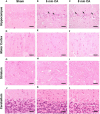Motor Cortex and Hippocampus Display Decreased Heme Oxygenase Activity 2 Weeks After Ventricular Fibrillation Cardiac Arrest in Rats
- PMID: 33015090
- PMCID: PMC7511667
- DOI: 10.3389/fmed.2020.00513
Motor Cortex and Hippocampus Display Decreased Heme Oxygenase Activity 2 Weeks After Ventricular Fibrillation Cardiac Arrest in Rats
Abstract
Heme oxygenase (HO) and biliverdin reductase (BVR) activities are important for neuronal function and redox homeostasis. Resuscitation from cardiac arrest (CA) frequently results in neuronal injury and delayed neurodegeneration that typically affect vulnerable brain regions, primarily hippocampus (Hc) and motor cortex (mC), but occasionally also striatum and cerebellum. We questioned whether these delayed effects are associated with changes of the HO/BVR system. We therefore analyzed the activities of HO and BVR in the brain regions Hc, mC, striatum and cerebellum of rats subjected to ventricular fibrillation CA (6 min or 8 min) after 2 weeks following resuscitation, or sham operation. From all investigated regions, only Hc and mC showed significantly decreased HO activities, while BVR activity was not affected. In order to find an explanation for the changed HO activity, we analyzed protein abundance and mRNA expression levels of HO-1, the inducible, and HO-2, the constitutively expressed isoform, in the affected regions. In both regions we found a tendency for a decreased immunoreactivity of HO-2 using immunoblots and immunohistochemistry. Additionally, we investigated the histological appearance and the expression of markers indicative for activation of microglia [tumor necrosis factor receptor type I (TNFR1) mRNA and immunoreactivity for ionized calcium-binding adapter molecule 1 (Iba1])], and activation of astrocytes [immunoreactivity for glial fibrillary acidic protein (GFAP)] in Hc and mC. Morphological changes were detected only in Hc displaying loss of neurons in the cornu ammonis 1 (CA1) region, which was most pronounced in the 8 min CA group. In this region also markers indicating inflammation and activation of pro-death pathways (expression of HO-1 and TNFR1 mRNA, as well as Iba1 and GFAP immunoreactivity) were upregulated. Since HO products are relevant for maintaining neuronal function, our data suggest that neurodegenerative processes following CA may be associated with a decreased capacity to convert heme into HO products in particularly vulnerable brain regions.
Keywords: biliverdin reductase; brain regions; cardiac arrest; enzyme activity; global cerebral ischemia; heme degradation pathway; neurodegeneration; reperfusion injury.
Copyright © 2020 Warenits, Hatami, Müllebner, Ettl, Teubenbacher, Magnet, Bauder, Janata, Miller, Moldzio, Kramer, Sterz, Holzer, Högler, Weihs and Duvigneau.
Figures








Similar articles
-
Heme oxygenase-1 (HSP-32) and heme oxygenase-2 induction in neurons and glial cells of cerebral regions and its relation to iron accumulation after focal cortical photothrombosis.Exp Neurol. 2001 Mar;168(1):1-22. doi: 10.1006/exnr.2000.7456. Exp Neurol. 2001. PMID: 11170717
-
Permanent focal and transient global cerebral ischemia increase glial and neuronal expression of heme oxygenase-1, but not heme oxygenase-2, protein in rat brain.Neurosci Lett. 1996 Jun 7;210(3):205-8. doi: 10.1016/0304-3940(96)12703-8. Neurosci Lett. 1996. PMID: 8805131
-
Biliverdin reductase is heat resistant and coexpressed with constitutive and heat shock forms of heme oxygenase in brain.J Neurochem. 1993 Sep;61(3):1015-23. doi: 10.1111/j.1471-4159.1993.tb03615.x. J Neurochem. 1993. PMID: 8360669
-
The heme oxygenase/biliverdin reductase pathway in drug research and development.Curr Drug Metab. 2009 Jul;10(6):579-94. doi: 10.2174/138920009789375405. Epub 2009 Jul 14. Curr Drug Metab. 2009. PMID: 19702533 Review.
-
The sinister face of heme oxygenase-1 in brain aging and disease.Prog Neurobiol. 2019 Jan;172:40-70. doi: 10.1016/j.pneurobio.2018.06.008. Epub 2018 Jul 29. Prog Neurobiol. 2019. PMID: 30009872 Review.
Cited by
-
Ischemia-Reperfusion Programming of Alzheimer's Disease-Related Genes-A New Perspective on Brain Neurodegeneration after Cardiac Arrest.Int J Mol Sci. 2024 Jan 20;25(2):1291. doi: 10.3390/ijms25021291. Int J Mol Sci. 2024. PMID: 38279289 Free PMC article.
-
A resting-state functional magnetic resonance imaging study of altered functional brain activity in cardiac arrest survivors with good neurological outcome.Front Neurol. 2023 Apr 20;14:1136197. doi: 10.3389/fneur.2023.1136197. eCollection 2023. Front Neurol. 2023. PMID: 37153675 Free PMC article.
-
Neurologic Deficit Score at 4-5 Days Post-eCPR Predicts Long-Term Brain Dysfunction in Rats Following Cardiac Arrest.Biomolecules. 2025 May 16;15(5):732. doi: 10.3390/biom15050732. Biomolecules. 2025. PMID: 40427625 Free PMC article.
References
-
- Nolan JP, Neumar RW, Adrie C, Aibiki M, Berg RA, Boettiger BW, et al. . Post-cardiac arrest syndrome: epidemiology, pathophysiology, treatment, and prognostication. A Scientific Statement from the International Liaison Committee on Resuscitation; the American Heart Association Emergency Cardiovascular Care Committee; the Council on Cardiovascular Surgery and Anesthesia; the Council on Cardiopulmonary, Perioperative, and Critical Care; the Council on Clinical Cardiology; the Council on Stroke. Resuscitation. (2008) 79:350–79. 10.1016/j.resuscitation.2008.09.017 - DOI - PubMed
LinkOut - more resources
Full Text Sources
Miscellaneous

